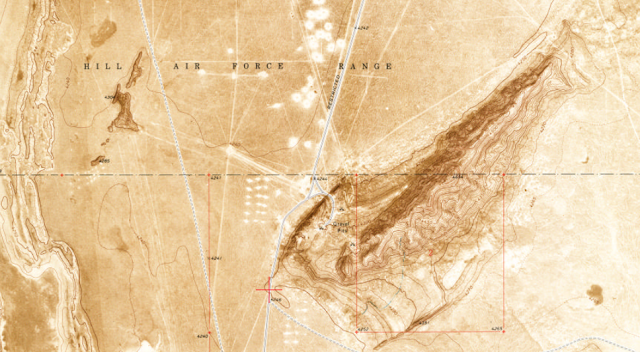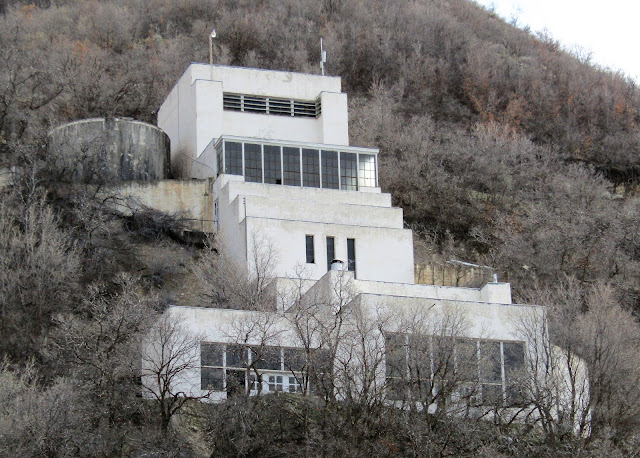A Temple for the Gentiles? Early Utah Politics and the Salt Lake City - County Building
By Peter
If you start to look into the history of the Salt Lake City and County Building, you might find a phrase like this, from the Wikipedia article on the building:
Similar sentiments appear in a 2013 Salt Lake Tribune article and on the official Temple Square visitor's guide page.
Construction of the building was riddled with controversy. During the late 19th and early 20th centuries the City and County Building was the symbol of non-Mormon citizens' open defiance of The Church of Jesus Christ of Latter-day Saints. It was designed to rival the Salt Lake Temple as the city's architectural centerpiece. It is even thought that the building's clock tower and statues were designed to mimic the temple's spires and statue of the angel Moroni.
 |
| The City and County Building from the top of the Tribune Building on Main Street. |
It's easy for me to see why this is a compelling argument. There was an angry, bitter, sometimes violent divide between Mormons and non-Mormons (or Gentiles) in the middle and late 19th Century. Non-Mormon newspapermen attacked the collection of tithing and construction of the Salt Lake Temple as destructive to the local economy, and the building was constructed under a Gentile city administration. There are also all sorts of things you could say about sacred and secular geography and the monumental style of the City and County Building. The Wikipedia article even calls attention to the statue of Columbia that originally adorned the central tower, an obvious knock-off of the Angel Moroni. But a look at the sources at the time shows that, while funding and construction of the building were acrimonious and drawn up along party and religious lines, the building in Washington Square was probably not constructed as a secular counterweight to the sacred Temple Square.
 |
| Salt Lake City in 1860. |
We'll begin our story in the 1860s, around 15 years after the first Mormon settlers arrived. The Saints had been left largely to their own devices for the first ten years in Utah, until the arrival of federal soldiers heralded the beginning of the Utah War. The presence of non-Mormon soldiers was an irritation that led directly to the source of much later contention: mining.
Colonel Patrick Connor and his men from California and Nevada arrived in 1862 to take over the watch over the Mormons during the Civil War. Colonel Connor was enterprising and encouraged his men to prospect for gold and silver. Precious metals were originally discovered in Bingham Canyon in the Oquirrh Mountains in 1863 and Little Cottonwood Canyon in the Wasatch Mountains in 1864. Brigham Young discouraged the Mormons from engaging in mining, but many members participated.
The development of mines brought in the first large influx of non-Mormons after the troops, while the completion of the transcontinental railroad brought in the next. Although worried about the implications of this increase in the Gentile population, Church leaders invested in and encouraged the completion not only of the transcontinental railroad, but also of branches to reach more populated areas. The railroad set up the first serious conflict between Saints and Gentiles as Corinne, a former end-of-the-track town, quickly grew into a proud competitor for Salt Lake City on the basis on transshipping goods for the Montana mines from the railroad onto wagons. The Burg on the Bear for a time entertained notions of becoming the official capital of the territory, but saw its hopes dashed as the Utah Northern Railway (one of the Mormon branches) built through Cache Valley to a more convenient transshipment point in Idaho by the 1870s. Corinne quickly dwindled and many of its prominent businessmen and citizens shifted to Salt Lake City or Ogden.
 |
| Corinne, 1869 |
There, they met wealthy, but dissatisfied, Mormon and ex-Mormon merchants such as William Godbe and the Walker brothers. As the number of Gentile merchants grew in the territory and mining wealth flowed to them, Brigham Young encouraged the Saints to increase their levels of cooperation and communalism. This led to the establishment in 1866 of the Zion's Cooperative Mercantile Institution (ZCMI) and an effective prohibition on trade with or patronization of Gentile businesses. Although many Mormon merchants joined the cooperatives, others disagreed with Brigham Young's policies. When they began publishing their objections, many of the group known as the Godbeites were excommunicated. The banded together with Gentiles to form the Liberal Party in opposition to the Church-controlled Peoples Party in 1870. To air their grievances and support their party, they began publishing the Mormon Tribune in 1871, soon to change its name to the Salt Lake Tribune.
Utah politics reflected this divide for the next 20 years. The People's Party generally had the majority as Mormons made up a large majority of nearly every jurisdiction in the territory. The Liberal Party worked to convince the federal government to appoint unfriendly territorial officials, impede statehood, and crack down on the practice of polygamy in specific and the LDS Church in general. The vitriol of the era was openly bandied back and forth from the anti-Mormon papers (Salt Lake Tribune and Salt Lake Herald) and pro-Mormon papers (Deseret News and the Daily Telegraph, the pugnacious younger brother to the News).
With the continued influx of outsiders and the disenfranchisement of large segments of the population through punitive anti-polygamy legislation (including women in general) the Liberal Party began to gain more and more influence. They finally triumphed in the municipal elections in Salt Lake City in 1890.
At this point, a discussion about replacing the 1860s city hall and county courthouse with a joint building had been ongoing for several years. Several competitions had been held and contracts awarded, but work had never progressed beyond digging the foundations. The anti-Mormon papers had been critical of these efforts, not particularly because they disagreed on the need for more space for city government, but because they thought the money could be better spent elsewhere paving streets and providing additional water. When the Liberals came into power, however, they had a change of heart.
 |
| City and County Building not long after dedication. |
Moving the site of the building to Washington Square, a park and athletics ground, they held a new competition and selected the firm of Proudfoot, Bird, and Monheim to design it. They chose to use the monumental, stone Richardsonian Romanesque style (my favorite style). The essential boxiness of the design was obscured through extensive exterior decoration. The building was constructed of Kyune sandstone from the far southeastern corner of Utah County, brought in on the new Denver & Rio Grande Railroad. Work began on the foundation in 1891 (difficulties arose because of the sandiness of the soil) and the building was dedicated in 1894, one year after the Salt Lake Temple. Interestingly, both buildings were dedicated by Wilford Woodruff.
 |
| The Salt Lake Temple, for comparison. |
The Church dropped the practice of polygamy beginning in 1890 and the People's Party dissolved in the same year to allow its members to join national parties in a push to reach statehood . Henry D. Moyle recorded a conversation between leaders of the People's Party and George Q. Cannon, a member of the LDS Church's first presidency. Cannon suggested that the time had come to remove the political divisions between Saints and Gentiles, and that if all of the members of the People's Party joined the Democrats (the Republicans were the main sponsors of anti-polygamy crusades), the division would continue. Moyle objected that he honestly agreed with the Democratic platform. Cannon suggested that Moyle and others who felt likewise should follow their consciences and vote Democratic. Anyone who didn't care could join the Republican party.
 |
| A decorative element on the facade. |
The Liberal Party, not trusting the dissolution of the People's Party, hung around until 1893 when they faded away. Utah became a state in 1896 and the City and County building served as the state capitol until 1915 when the current capitol was constructed. Major and minor restorations have taken place over the years, because sandstone is not an ideal building material. These included cutting the entire building free of its foundation and placing it on rubber and metal base isolators to allow the building to shift without crumbling in an earthquake.
 |
| This is what happens when you build with sandstone. It's called delamination. Don't build with sandstone. |
For additional items of interest in Salt Lake, see my posts on the Salt Lake Army Air Force Jeep Ranges, the Phantom Wye, and the Longest Conveyor Belt in the World.
A note on Washington Square: It was the first camping spot in the city for the original Mormon wagon trains, and was the first stopping place for most pioneers coming into the city in later years. It was also the site of athletic contests including cricket, cycling, and baseball. In particular, it seems like just about every business in town had a baseball team, and if they weren't big enough they would join with another business. They would issue direct challenges to other teams of similar quality through the newspapers. The other team would accept, and they would play at Washington Square.
A note on Washington Square: It was the first camping spot in the city for the original Mormon wagon trains, and was the first stopping place for most pioneers coming into the city in later years. It was also the site of athletic contests including cricket, cycling, and baseball. In particular, it seems like just about every business in town had a baseball team, and if they weren't big enough they would join with another business. They would issue direct challenges to other teams of similar quality through the newspapers. The other team would accept, and they would play at Washington Square.


Comments
Post a Comment